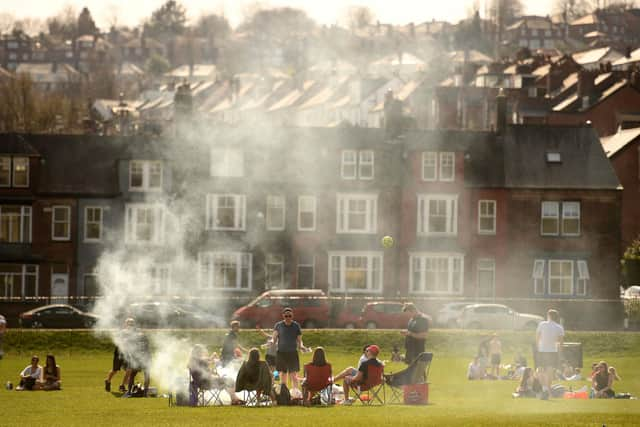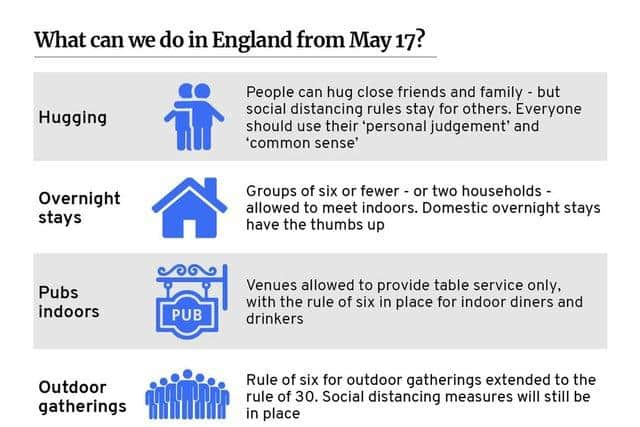How many people can meet outside? UK rules explained following May 17th changes - and when they change again
and live on Freeview channel 276
Falling Covid cases and the success of the vaccination rollout so far has allowed lockdown restrictions to be gradually eased across the UK.
Lockdown measures have been eased for the third time in England – meaning most legal restrictions on meeting others outdoors have been lifted but gatherings of more than 30 people outdoors are still illegal.
Advertisement
Hide AdAdvertisement
Hide AdFrom 17 May, further sectors of the economy were allowed to open up again, includuing the resumption of international travel, as part of the next phase in the lockdown roadmap.


So, what rules changed in England, Scotland, Wales and Northern Ireland from 17 May – and how many people can now meet indoors?
Here’s what you need to know.
Is the rule of six still in place?
The rule of six only remains indoors in law as England’s roadmap eases.


This means six people can meet indoors (or two households of any size) can meet, with overnight stays allowed while 30 people can gather together outdoors.
What changed in England on 17 May?
Advertisement
Hide AdAdvertisement
Hide AdThe UK Government confirmed that Step 3 of the lockdown roadmap in England would go ahead as planned on 17 May, following a review of the data and four key tests.
The most high-risk sectors have now reopened, with Covid-secure guidance in place. This includes the reopening of:
- indoor hospitality, with no requirement for a substantial meal to be served alongside alcoholic drinks, and no curfew. The requirement to order, eat and drink while seated (‘table service’) will remain
- remaining outdoor entertainment, such as outdoor theatres and cinemas
Advertisement
Hide AdAdvertisement
Hide Ad- indoor entertainment, such as museums, cinemas and children’s play areas
- remaining accommodation, such as hotels, hostels and B&Bs
- adult indoor group sports and exercise classes
- some large events, including conferences, theatre and concert performances and sports events. Controlled indoor events of up to 1,000 people, or 50 per cent of a venue’s capacity (whichever is lower) are allowed, as will outdoor events with a capacity of either 4,000 or 50 per cent capacity. The Government will also make a special provision for large, outdoor, seated venues where crowds can be safely distributed, allowing up to 10,000 people or 25 per cent of total seated capacity.
- international travel
-Weddings, receptions, funerals, and commemorative events, including wakes, can now go ahead from this date with up to 30 attendees.
Advertisement
Hide AdAdvertisement
Hide Ad- A broader range of stand-alone life events are also be permitted, including bar mitzvahs and christenings.
- Most legal restrictions on meeting others outdoors have been lifted, but gatherings of more than 30 people outdoors are still illegal.
- Indoors, people can meet socially in a group of six, or with one other household.
All remaining restrictions on social contact could be lifted from June 21, allowing for larger events to go ahead and nightclubs to reopen.
Advertisement
Hide AdAdvertisement
Hide AdHowever, the decision on whether to proceed with the planned roadmap out of lockdown - which would see a series of restrictions lifted in late June - could be delayed until the full extent of the spread of Indian variant is known.
Officials said eight areas including Bolton, Leicester, Kirklees, and the London borough of Hounslow were hardest hit by a Covid variant of concern and people there should not meet indoors.
What changed in Scotland on 17 May?
From 17 May, all areas of Scotlan, except Moray and Glasgow, moved from Level 3 to Level 2 restrictions.
At Level 2, you can meet socially in groups of up to:
- 4 adults from 2 households in private homes – and can stay overnight
Advertisement
Hide AdAdvertisement
Hide Ad- 6 adults from 3 households in an indoor public place, such as a café, pub or restaurant
- 8 adults from 8 households outdoors
All hospitality venues can now open until:
- 10.30pm indoors - alcohol will be permitted, and customers will have to book two hour time slots
- outdoors - local licensing laws apply
All organised sport and exercise activity can go ahead, except adult indoor contact sports.
Cinemas, theatres, concert halls, music venues, comedy clubs, amusement arcades, and bingo halls can open, subject to capacity constraints.
Advertisement
Hide AdAdvertisement
Hide AdOutdoor and indoor events can resume, with a maximum capacity of 100 indoors, 500 in outdoor seated venues, and 250 in outdoor free-standing venues, subject to physical distancing capacity requirements.
Universities and colleges can return to a more blended model of learning.
Adult organised non-professional performance arts can resume outdoors.
Scotland also moved to a traffic light system for international travel, similar to that already announced for England, although First Minister Nicola Sturgeon said Scots should “think seriously” about whether to take overseas holidays.
What will change in Northern Ireland in May?
Advertisement
Hide AdAdvertisement
Hide AdThe next phase of easing lockdown restrictions in Northern Ireland is due to take place a little later than the rest of the UK, with changes due to be implemented from 24 May at the earliest.
The Northern Ireland Executive has given this as a provisional date when more restrictions might be lifted, including:
- Reopening of indoor hospitality, including pubs and hotels
- Resumption of indoor group exercise
- Some indoor mixing of households in private accommodation
- Reopening of B&Bs and hotels
- Restarting of wedding receptions and funeral wakes
- Reopening of indoor visitor attractions (for instance, museums or skating rinks)
What changed in Wales on 17 May?
Advertisement
Hide AdAdvertisement
Hide AdFrom 17 May in Wales, all hospitality venues reopened for indoor service.
Indoor tourism accommodation, including hotels, hostels and B&Bs, also reopened, and indoor attractions, including cinemas, bowling alleys, theatres and stately homes, can now welcome visitors.
Welsh ministers have advised that people in Wales should only go abroad from 17 May for "essential purposes" and First Minister Mark Drakeford urged people to stay in Wales.
All of Wales has now moved to Covid alert level two.